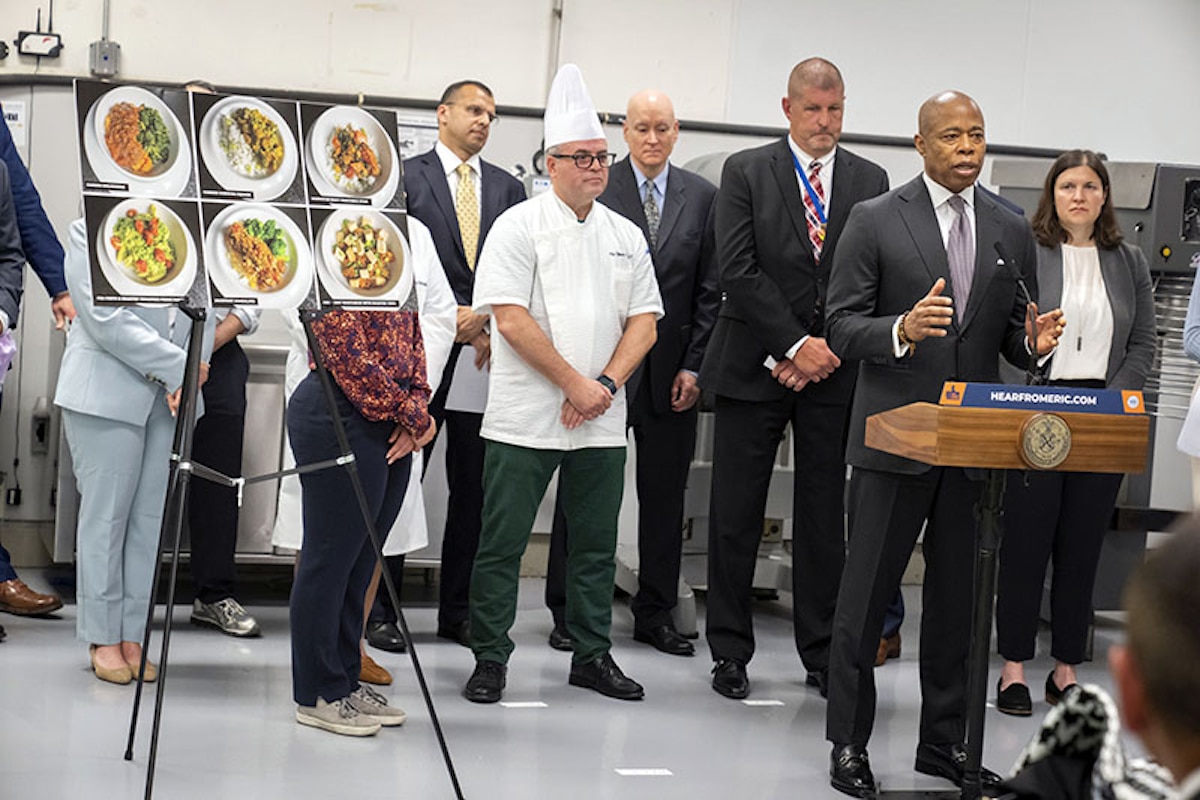NYC to Reduce Carbon Emissions From Food

 Why you can trust us
Why you can trust us
Founded in 2005 as an Ohio-based environmental newspaper, EcoWatch is a digital platform dedicated to publishing quality, science-based content on environmental issues, causes, and solutions.
New York City Mayor Eric Adams announced on April 17 that the city would aim to “reduce absolute carbon emissions from food purchases across its city agencies by 33 percent by 2030.”
This was after the city’s Department of Environmental Protection began to incorporate food emissions data into its overall greenhouse gas inventory, discovering that greenhouse gas emissions from the productions and consumption of food accounted for 20 percent of the city’s overall emissions.
According to a 2021 report from Food and Water Watch:
“Agriculture is also one of the largest human sources of climate change; across the entire production chain, it contributes 19 to 29 percent of all human-sourced emissions. Overproduction of commodities and meat, food waste, growing crops for fuel, and use of synthetic fertilizers produced from fossil fuels all enlarge this footprint.”
Mayor Adams, a noted vegan, said that “plant-powered food isn’t just good for our physical and mental health, but good for the planet as well… The way we eat impacts everything, and now we’re going to do more to impact everything for the better.”
The initiative is twofold. The purchasing part of it is the first part, while the second part is a challenge to the private sector called the Plant-Powered Carbon Challenge. The city is asking private, institutional and nonprofit sectors to voluntarily take a closer look at the environmental impact of their procurement practices and is providing resources to help them measure their carbon footprint.
New York City has already taken very small steps to move towards more plant-based foods in the city. It introduced “Plant-Powered Fridays” at public schools, but an investigation from 2022 by The Counter, which has since ceased publication, noted some skepticism about the meals being vegan, and also showed a picture of processed food on the menu. Nonetheless, the initiative continues at public schools.
The NYC Health + Hospitals system introduced plant-based primary dinner options at all 11 of its hospitals early this year, which builds on the Meatless Monday initiative started in 2019. All of these initiatives are related to a report released in late 2021 that took aim at the city’s food purchasing infrastructure, with the goal, according to the report, to tie food purchasing to five metrics: “nutrition, support for local economies, a valued food production and delivery workforce, environmental sustainability and animal welfare.” New York joined Los Angeles, which adopted a similar purchasing policy back in 2012.
New York City spends around $300 million purchasing food for hospitals, prisons and public schools. And while its spending on beef products is small, at just around one percent of the overall food budget, it is well-documented that beef is a very high contributor to carbon emissions.
A Good Food Purchasing Metrics document from March of this year did show that, according to city data, the total greenhouse gas emissions per meal has steadily decreased from 2019, when the figure was 2.32 kg CO₂e per 1,000 kcal. In 2021, the figure was down to 1.74 kg CO₂e per 1,000 kcal.
New York is not the first to undertake this kind of “good food purchasing.” The Good Food Purchasing Program is a coalition of partners that aims to change the habits of governmental food spending. Its program uses the same five metrics that New York cited in its announcement: supporting local economies, sustainability, a valued workforce with support for unionization, animal welfare, and nutrition. The site publishes a map that shows at least ten cities in the U.S. that have adopted good food purchasing policies. These include:
- Austin, where two school districts have implemented the program.
- Los Angeles, where the Los Angeles Unified School District has increased spending on local and small farmers, and where the program has been implemented in a number of other departments, including at airports.
- Pittsburgh, where in 2021 the public schools passed the Good Food Purchasing Policy.
- The Cincinnati School Board, which in 2019 adopted the Good Food Purchasing Policy.
The U.S. Department of Agriculture is currently looking to update its standards on child nutrition for its school lunch program, which currently spends $13 billion and serves more than four billion lunches per year. It is proposing a section on “local procurement” as part of its overhaul of the standards, that would “expand geographic preference options by allowing locally grown, raised, or caught as procurement specifications (criteria the product or service must meet for the vendor’s bid to be considered responsive and responsible) for unprocessed or minimally processed food items in the child nutrition programs, in order to increase the procurement of local foods.” However, this change would not take effect, if it is indeed passed as part of the overhaul, until 2024 at the earliest.
Subscribe to get exclusive updates in our daily newsletter!
By signing up, you agree to the Terms of Use and Privacy Policy & to receive electronic communications from EcoWatch Media Group, which may include marketing promotions, advertisements and sponsored content.

 233k
233k  41k
41k  Subscribe
Subscribe 




